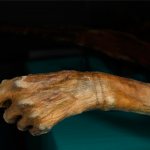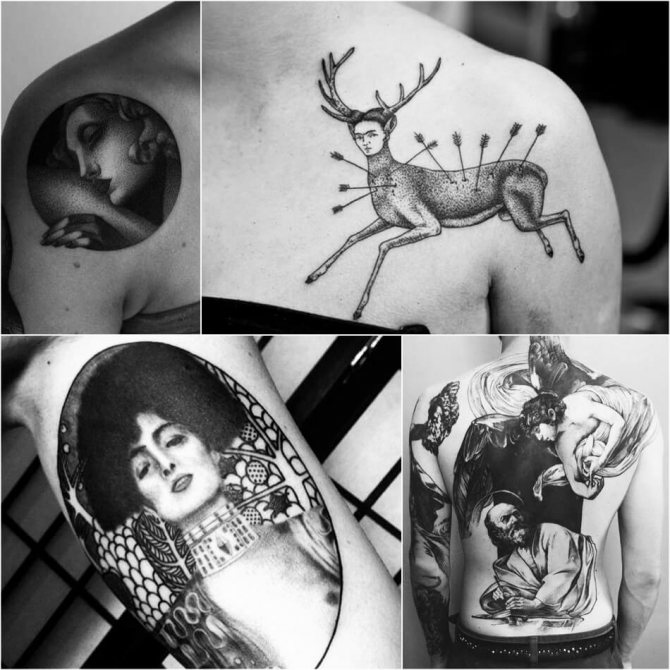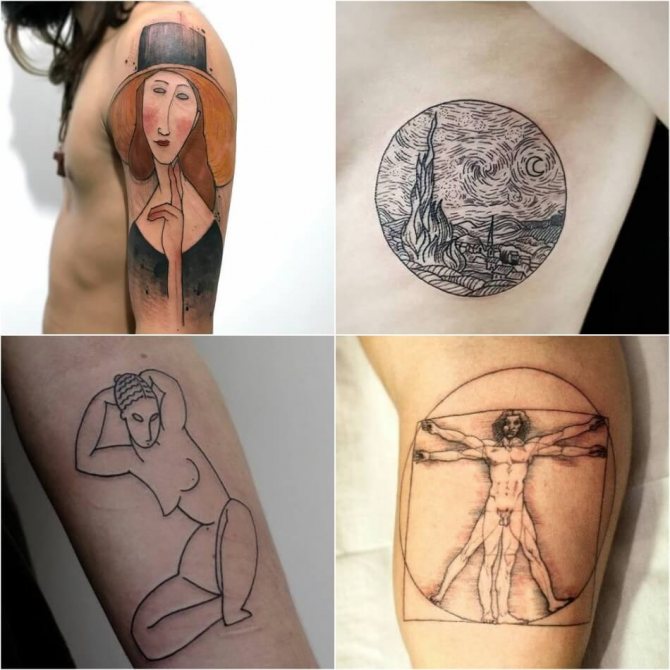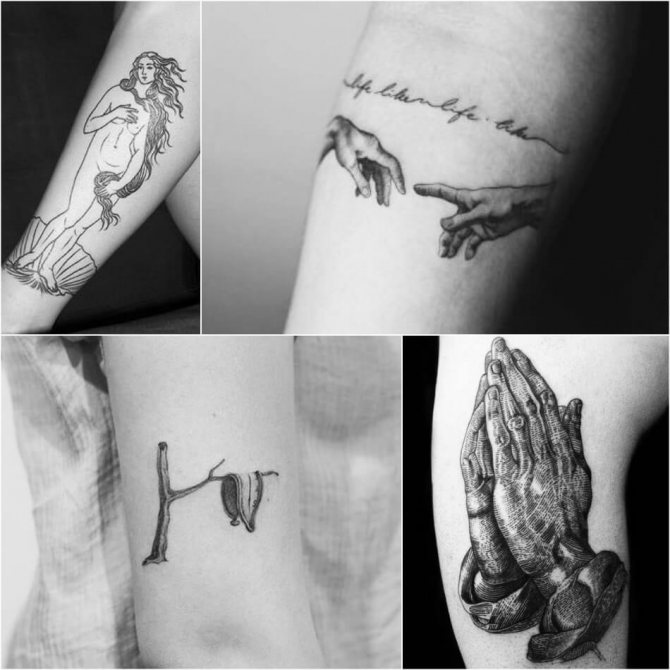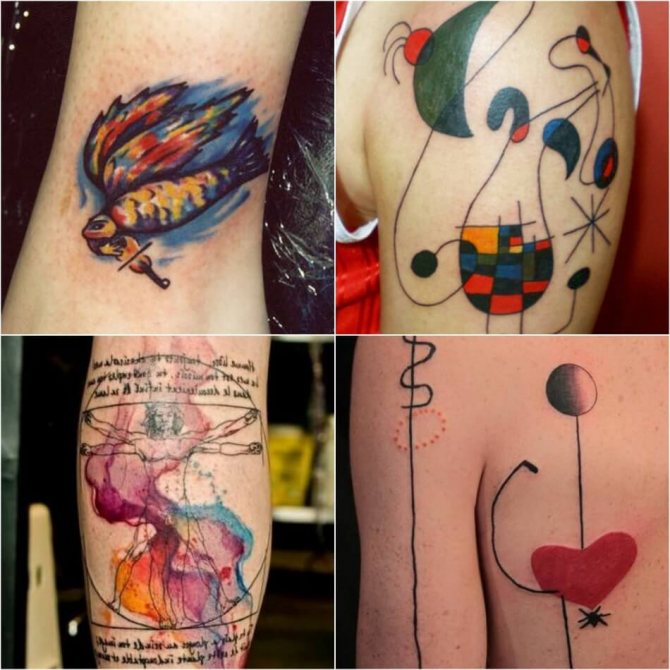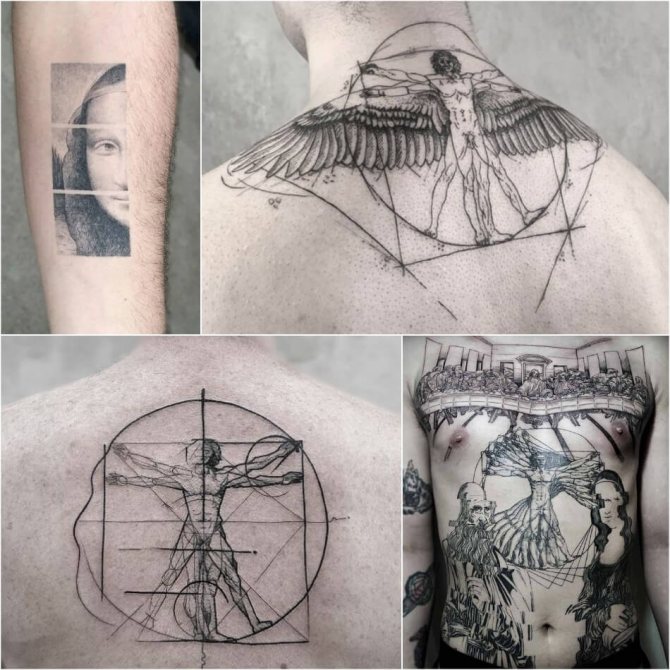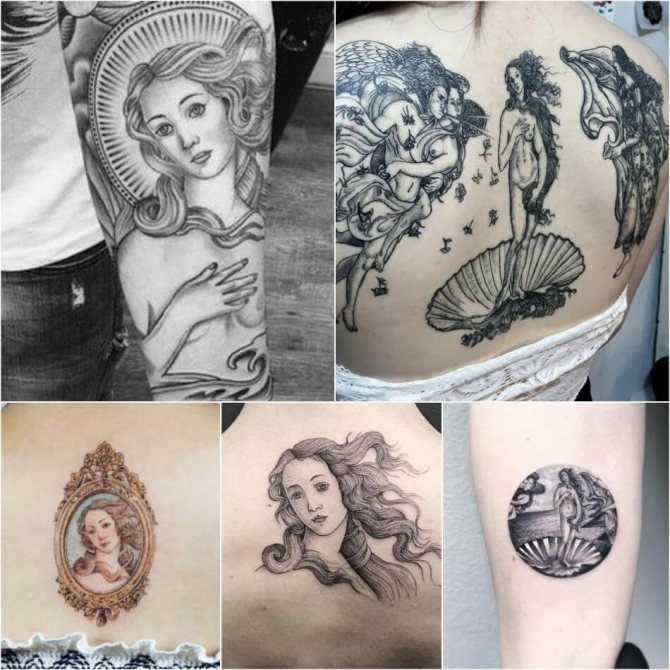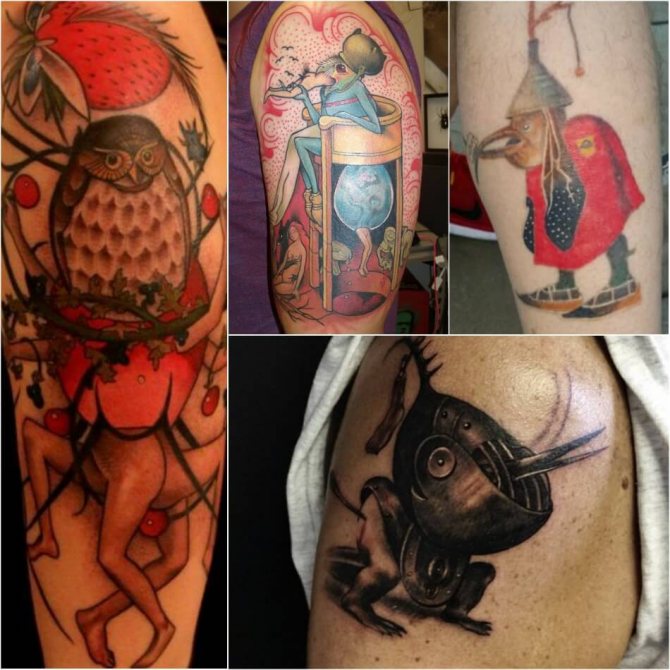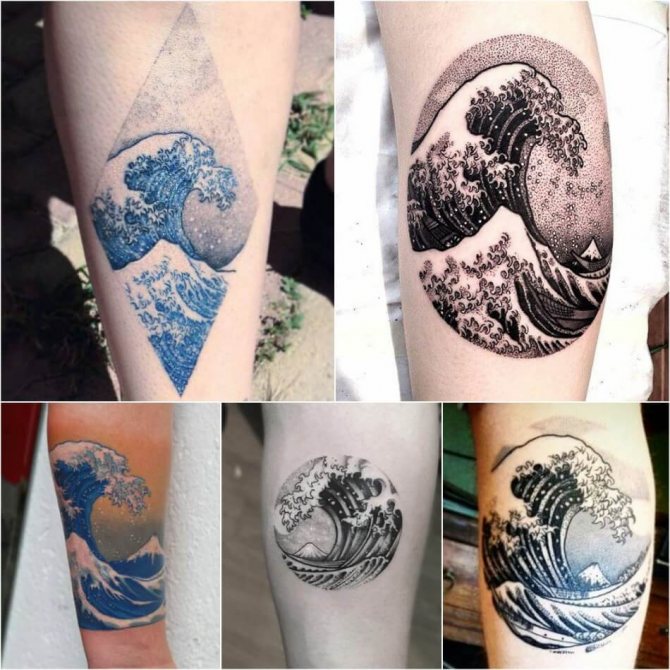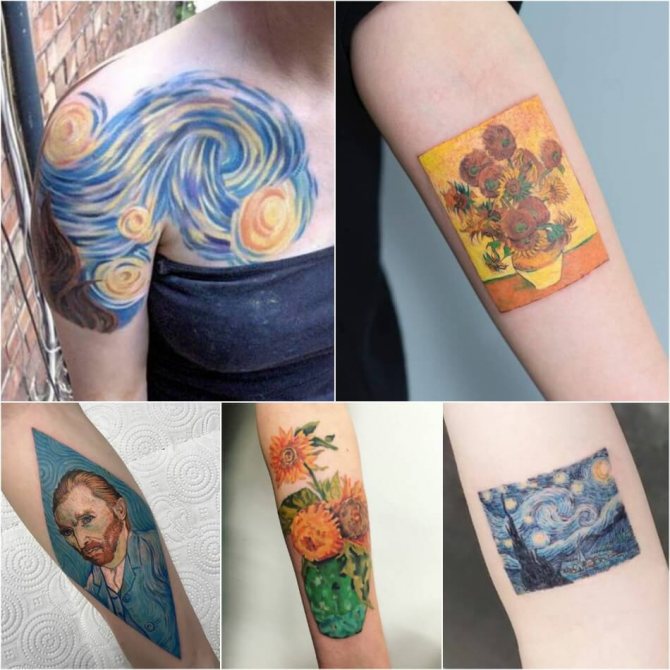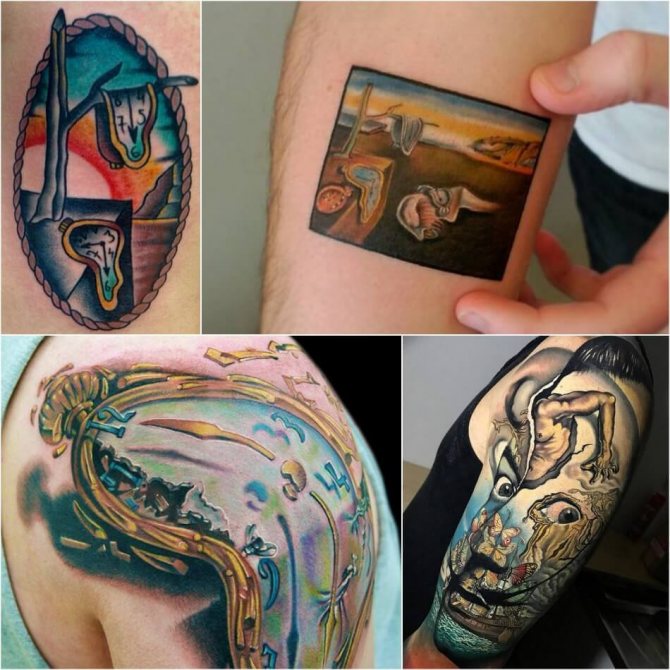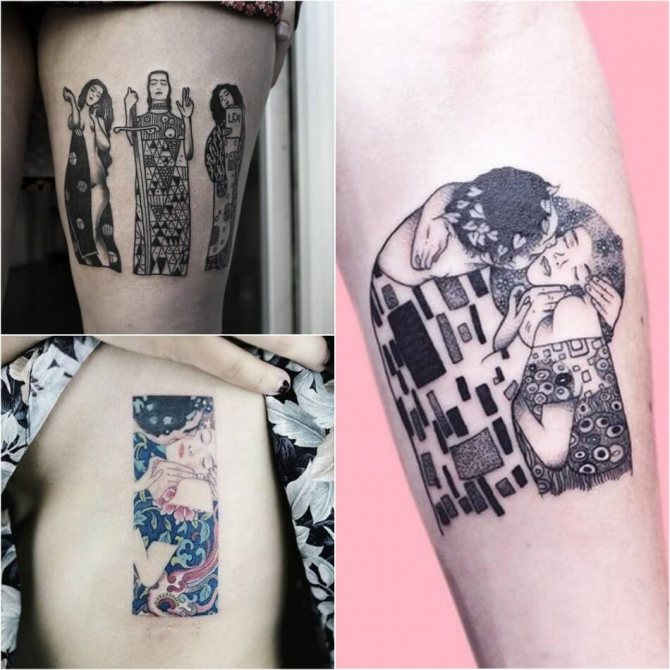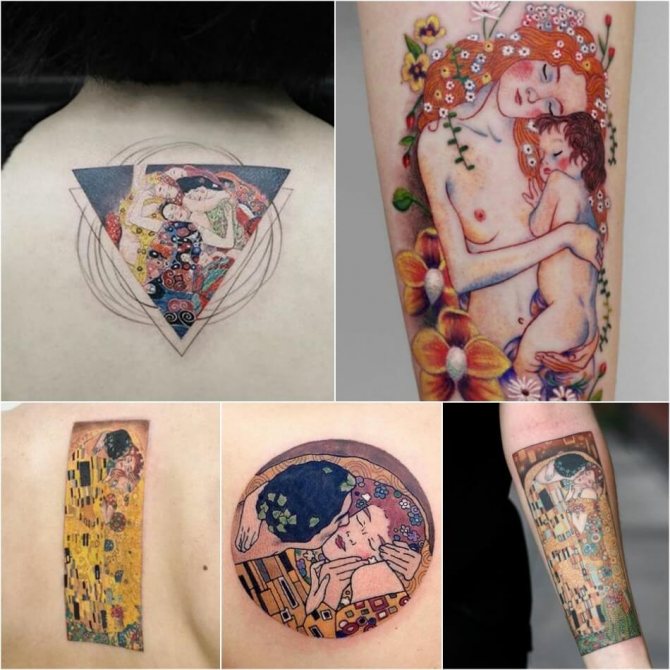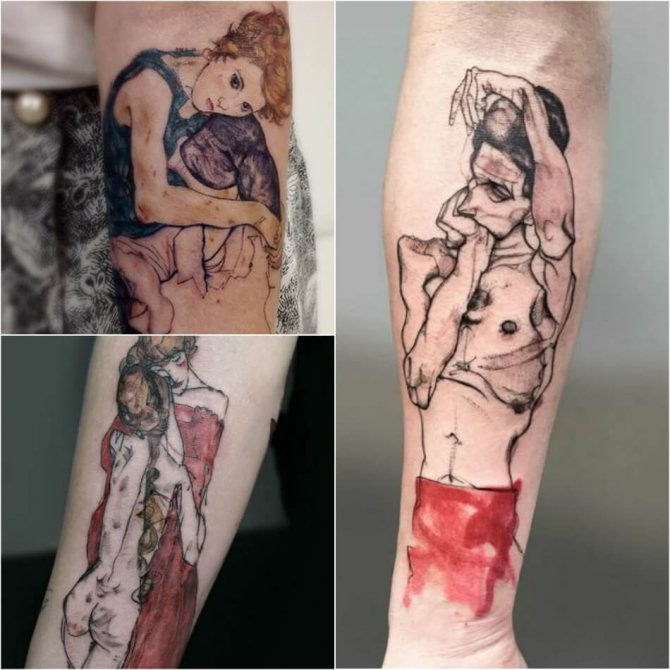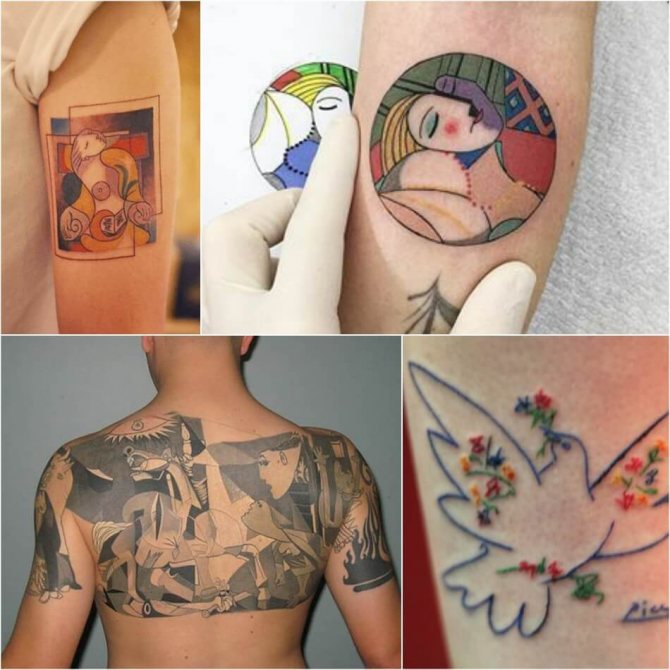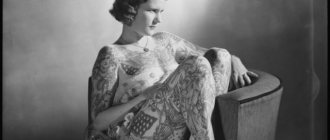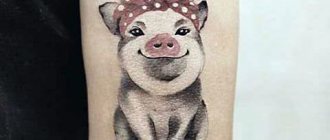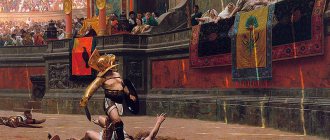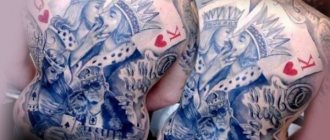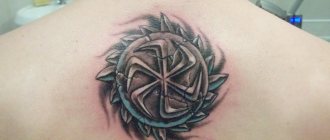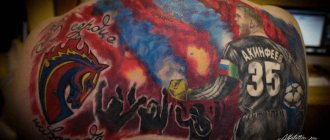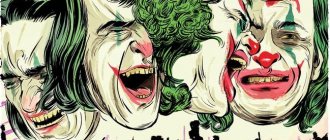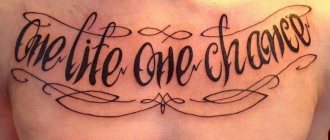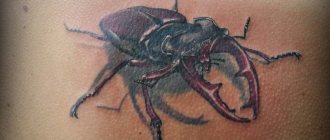Walking down the street, we see more and more people with a variety of tattoos. These can be inscriptions on the wrist or shoulder blade, multicolored patterns on the leg or mandalas on the arms. What does a tattoo mean to these people? Do they see it as a memorial or do they do it for body decoration?
There is a lot of talk right now about whether or not tattooing is considered art. Everyone from artists to fashion designers are beginning to turn to tattoos. Today, tattoos have come to be interpreted as a stylistic addition to the personality for a certain contingent of people.
Prehistoric tattoos
The history of tattooing stretches back to ancient times, even in prehistoric times people began to put patterns on their bodies. In 1991, German tourists accidentally discovered a dried-up body of a man in the Ötztal Alps, as it turned out later - the oldest mummy found in Europe. The body of Etzi (that was the name given to the find) was covered with tattoos of dots, lines and crosses. These drawings were made not with needles but in a manner similar to scarring: the skin was dissected and charcoal powder was poured into the resulting small incisions.
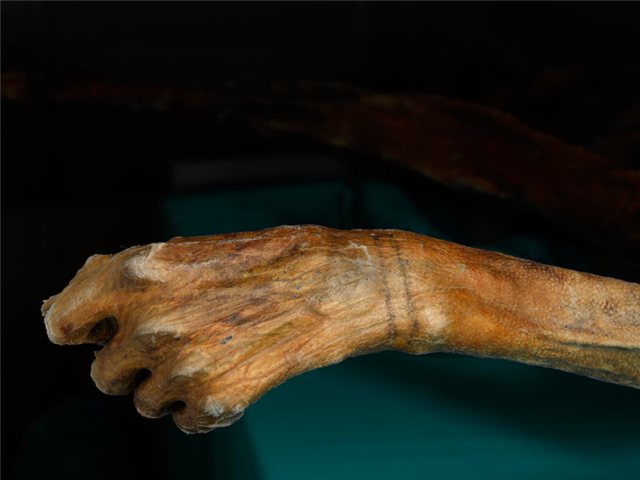
The geography of the early patterns on the body is quite extensive: tattoos were common among the inhabitants of the Marquesas Islands, the Maori - the indigenous population of New Zealand, as well as the Picts, Scotts and Britons tribes who lived in Western Europe in the days of ancient Rome.
In traditional communities, tattooing was a natural part of the culture. The drawings served the function of identification signs, with the help of which it was possible to understand who was in front of you: a highly revered man or a slave, whose marks on the skin signaled his low position.
Before the eighteenth century: Europe and the overseas experience
Speaking of the history of American tattooing, we must begin all the same with Europe - that's where those who made American tattoo culture as we see it today came from. Anthropological researchers, studying the phenomenon, have concluded that tattoos were common among early Christians wherever followers of that religion were in the minority and persecuted, such as Copts and Syrian Christians. The drawings in the form of crosses, hidden from view, replaced the sacramentals worn by them. Later in Europe, tattooing was forbidden by church authorities because the practice was contrary to biblical precepts, but was still allowed among crusaders who went to die for their faith in distant lands. Religious prohibition slowed down tattoo culture in Europe, and it resumed only after the active beginning of navigation.
The word "tattoo" itself came into use in the 18th century thanks to the around-the-world expeditions of James Cook, an English navigator, explorer and discoverer. Seafarers who encountered cultures and traditions that were radically new to them as they traveled across the Pacific and to the islands of Oceania sought to bring home evidence of what they had seen, including in the form of drawings on the skin using indigenous methods.
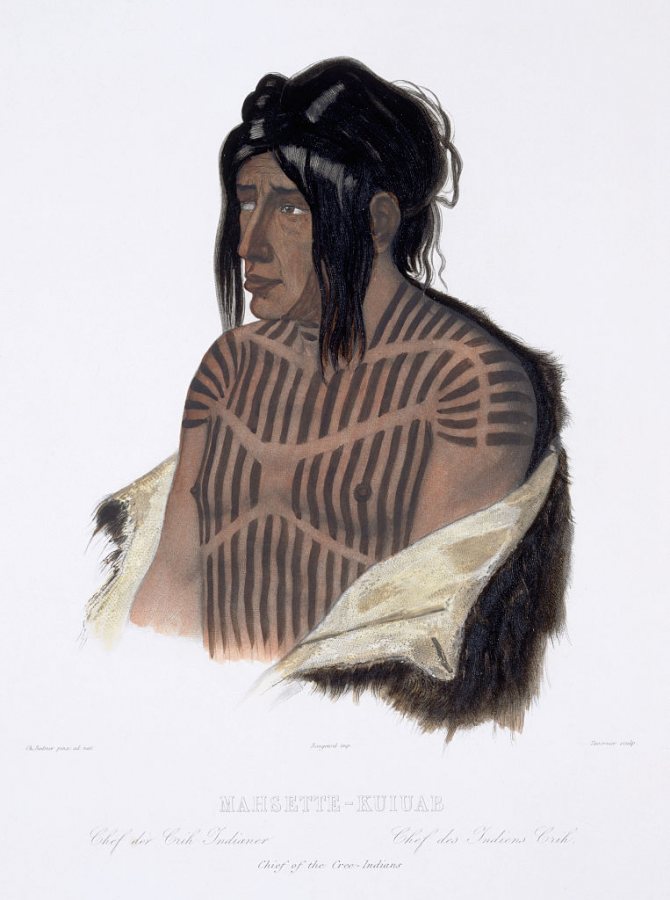

Historical Picture Archive/CORBIS/Getty Images
Mahsette Kuyab, head of the Cree tribe. The author of the drawing is Karl Bodmer.
Before Europeans arrived in the New World there was, of course, their own tattoo art, but Native American traditions did not affect the nascent tattoo culture of European colonizers: having learned the ways of tattooing, mariners developed their own visual tattoo language.
Circus legends: Captain Costentenus, Nora Hildebrandt and Anna Gibbons
Widespread interest in tattooing did not emerge until the seventeenth century, when the discoverers, returning from their travels, began to bring back with them tattooed savages. They assumed that in their homeland the public would want to gaze at the exotic spectacle.
Already in the XIX century people began to purposely turn their bodies into a collection of tattoos, because with such an extravagant appearance it was possible to ride with traveling circuses, to participate in street performances and earn money. At sideshows, staged at carnivals, banquets and fairs, everyone could see these bizarre people for a mere pittance: there were dwarfs, giants, Siamese twins, people with body deformities, overweight or very thin and, of course, men and women whose entire bodies were covered with tattoos.
In order to attract more spectators, circus performers invented legends for themselves. At the time, stories were popular that vividly described the dangers of the savage world, such as the tradition of the natives to tattoo prisoners. Such stories tickled the nerves of an impressionable public and piqued their interest.
One of the most common legends of the late 19th century was the story of Captain George Costentenus, discovered by Phineas Taylor Barnum, founder of one of the first museums of outlandish people and considered the ancestor of show business and the entertainment industry.
At his shows, Barnum introduced Costentenus as the most tattooed man in the world, calling him "a wonder of wonders among mortals." The Captain's entire body, including his head, face, and toes, was covered with colorful tattoos depicting mythical animals.
It was rumored that Costentenus was born in Albania and had tattoos of his own, but he told an entirely different story. According to the captain, as a child he was taken prisoner by Chinese Tatars in Burma, who forcibly tattooed him for three months, subjecting him to terrible torture. It was believed that the ritual of forcibly placing images on prisoners' bodies was special in nature, as a sign that one no longer belonged to oneself.
The story of the Captain, who survived millions of bloodletting injections, made a great impression on his contemporaries. Georg became a real star with unthinkable fees for that time, sometimes as high as $1,000 a week.
The success of Costentenus inspired organizers of fairground entertainment in the United States. Strolling circuses and their urban counterparts, museums of curiosities, began to show tattooed men and women, and all as one told incredible stories about the appearance of their drawings.
In the same museum in 1882 in New York, one of the most famous tattooed women, Nora Hildebrandt, began her career - she was the first of all the fairer sex to publicly display her drawings. Her legend was no less striking: in the Wild West, Nora and her father were captured by an Indian chief named Sitting Bull, and the latter, under threat of death, forced his father to make 365 tattoos on his daughter's body.


As usual, the story attracted a lot of attention, but later it turned out that the story from beginning to end was a fantasy, and the image on the body of Nora made her roommate, traveling tattoo artist Martin Hildebrandt.
Not all circus legends lured audiences with horror stories about torture. Anna Gibbons, for example, was said to be the girl, born in 1893 to a poor farming family, who lost her father at age 14. To earn her living, she covered her body in patterns and joined a traveling circus.
In fact, it was not quite like that: Anna's father actually died, and soon after his passing, the girl left home to earn her own living. After some time, she met tattoo artist Charles Gibbons and married him. Only a few years after the wedding, Anna asked her husband to cover her body with tattoos: so she decided to advertise her husband's work by showing the drawings to the public.
Tattooing as an art form. Pros and cons.
- History of tattooing .......................................5
- Types of tattoos ...........................................................6-10
- Interesting facts ............................................................11
- Results of a study of teenagers. ..................................12
- Final part. Pros and cons. ..........................................13-15
- Literature .............................................................................16
- Leading
Probably there are few people who at least once in their life would not think of taking the example of friends, colleagues or celebrities and make yourself some, even the smallest tattoo. Some boldly went to the salon and brought the idea to life, others were frightened by the prospect of walking around marked for the rest of their lives and did not dare to take the unusual step.
Today tattooing is a relatively young direction in Russian art, not having a rich and thorough tradition. It changes due to creativity and diligence of tattoo masters with their own styles amazing with originality, individuality and views on tattoo-religion and tattoo-politics.
The aim of the study: - To consider tattooing as an art form. To weigh all the pros and cons.
Research objectives: - To learn the history of tattooing
- To consider types of tattoos and their meaning To study teenagers' opinions on tattoos
- find out interesting facts
Hypothesis
- Tattooing is by far the most popular art form, and many teenagers dream of getting a tattoo. It is beautiful, but not safe for health. Research methods:- Survey method (questioning and conversation); - Literature study (abstracting); - Statistical method (diagrams).
- Main part
Tattoos as a type of art.
Tattoo (tattoo, tattooing) - the process of applying a permanent (persistent) image on the body, by local trauma of the skin with making in the subcutaneous tissue dye pigment. As a rule, a tattoo and its type is determined by the client himself or by the conditions of life and society. Tattoo has characteristic distinctive features, being subdivided into types, styles and ways of making. It refers to decorative modifications of the body.
Tattoo - Tattoo is a term borrowed from the Polynesian language, in the Tahitian dialect the word "tatau" means drawing. The word was introduced into the English language by the outstanding English traveler James Cook. He used it in an account of a voyage around the world, published in 1773. Before that, tattooing in Europe was a way of decorating and identifying the human body and was not distinguished by a separate name. The terms used before Cook defined tattooing in the general mass of techniques of direct decoration and identification of the human body. Sometimes were borrowed from the jargon and slang of various social groups.
Russian tattoo culture is considered almost lost, until the birth of criminal structures. That's why in Russia and Russian tattoo styles tattoo synonyms can be words derived from criminal slang: "portak", "portachka", "nakolka", "mast". Slang words define either the process of tattooing itself (tattoo, tattoo) or identification within the hierarchy (suit). Criminal tattooing in Russia has become a socially accepted culture because, the true canons of Slavic tattooing are unknown or lost.
History of the origin of tattooingIt is hard to say when a person first put a drawing on his skin. However it is known for certain that the history of tattoos counts no less than 60 thousand years. The oldest tattoos were discovered during the excavations of the Egyptian pyramids. The age of the discovered mummies is approximately four thousand years, but the drawings on the dried skin are clearly distinguishable. Scientists say that tattoos appeared much earlier - during the primitive communal system. They acted as not only ornaments, but also were considered a sign of a totem, family, tribe, testified to the social belonging of their owners, and were endowed with magical power. As for the reasons of their appearance, there is no clarity here as well. According to one theory - it is a progression from each regular natural skin damage, which were accidentally received by people of the Stone Age. The bruises and wounds merged into a single, bizarre scar that distinguished their owner from his fellow tribesmen as a successful hunter and a brave warrior. In the course of time, primitive families grew larger and began to unite into small organized communities, so there was a need to make special marks on the skin, which had a specific meaning within a particular social group. The Indian tribes of Polynesia and Indonesia, where tattoos were practiced more often than anywhere else, continually passed down the skill of tattooing from generation to generation. Virtually every aspect of their lives has a connection to body art, from birth to death. There isn't a part of the body where local artists haven't worked hard.
Types of tattoos
1.Old School - A style of tattoo that existed throughout Europe and America. The history of the style began at the end of the nineteenth century. The most popular in this trend were drawings of skulls, hearts, ribbons, angels, crosses, fire, flowers and anchors. Often the tattoos were made by sailors, so it is not uncommon to see inscriptions in this style with names of locals, names of great events, quotes. These tattoos are done in bright colors that are framed with a bold black outline. More attention should be paid to the history and the symbols themselves: Sailors were the first people to revive the art and practice of tattooing in Western countries, as they were the first to visit the Pacific islands of Polynesia and other states in Southeast Asia. Cook, in his explorations of the islands of Tahiti, Hawaii, and Zealand, was the first to take notes and sketches of tattoos of the natives. 2.Mechanics. Biomechanics is one of the most interesting trends in tattooing, which appeared in the early 80s of XX century. Every year biomechanics becomes more and more popular thanks to such feature of design of this direction as connection of alive with electronic, mechanical and sometimes alien. This began to manifest itself primordially in tattoos, which depicted mechanical parts on the human body, as if released from the covering of the skin. The most popular realization of biomechanical design today is torn flesh with visible moving parts of some mechanism or metal structure.
3.Treble. Trible Style. Treble tattoos are a monochromatic geometric pattern, usually black, but today it is no longer uncommon to use different gradations of gray and even bright colors. Such tattoos can be applied to almost any part of the body - back, shoulder, arm, leg.
4.Celtic tattoos.Celtic culture and heritage have been preserved through paintings and art without written documentation. Therefore, Celtic tattoos hold much more meaning than meets the eye.
Celtic people were very well educated in the areas of religion, philosophy, geography, and astronomy. Most Celtic tattoos are a representation of one of these areas. Even with all their education, Celtic culture is filled with superstition. Some of the Celtic tattoos are guards against evil spirits.
Celtic tattoos show intricate designs that are very detailed. Celtic tattoo art is often represented by multiple patterns that intertwine with each other. There can also be spirals, and existing animals. Celtic tattoos were often a way to showcase their heritage.
The most common design used for this purpose was the three leaf-covered shamrocks. This is a representation of good luck. Of course, the number three plays an important role in protecting against superstition and is believed to be sacred. Triskel is a symbol that is made up of three spirals. Another popular design is the harp, a Celtic instrument. For those interested in preserving their Celtic heritage, Celtic tattoos can be a great choice. The circle of the cross is meant to represent the eternal love of Christ. The crossroads represent the different ways that each person takes their path to discover and maintain their relationship with Christ. The knots of the Celtic tattoo have no beginning and no end. Throughout the world, this pattern is known to represent infinity and eternity.
-Celtic knots are a very popular tattoo design lately. Celtic knots have no beginning or end. It is meant to represent a continuous relationship between the material world and the spiritual world. Celts believe in a continuous flow of love, faith, and life.Celtic Butterfly TattoosMany women find that Celtic butterfly tattoos offer them a colorful object that matches Celtic culture. Butterfly wings are designed from interwoven loops and spirals. You can create a Celtic butterfly tattoo unique to you by adding some details or special colors. If you want a large, detailed Celtic butterfly tattoo, you need to locate it on your shoulder or lower back. You can place a small Celtic butterfly tattoo on your ankle or arm.
5.Ethno. Ethnic tattoos have at their core ornaments and motifs characteristic of the fine art of ancient peoples. Such tattoos reflect the national identity. However, ethnic tattoos can contain not only ornaments characteristic of the culture, but also images, which are state symbols.
There are the most popular ethnic tattoos, such as Japanese, Slavic, Celtic, Polynesian, and others.
Traditional for every culture motifs and patterns, applied to the body with a tattoo, can be succinctly combined with modern subject images. The result is original images, which can be safely attributed to the samples of a new, synthesized direction in the art of artistic tattooing.
- Japanese tattoos
Japanese tattoos are called irezumi or horimono in Japanese. In Japan, tattoos are usually considered a symbol of the yakuza (Japanese Mafia) and are often viewed negatively. For example, many public places such as saunas in Japan do not allow customers who have tattoos. Traditional Japanese tattoos often cover the arms, shoulders, and back.
Popular Japanese tattoos include dragon tattoos, flowers, ocean, and more. In recent years, modern tattoos have become popular among young people, and tattooing is often done in large cities. There are many Japanese tattoo parlors and tattoo artists in Japan. It is best to contact them by phone or email before you visit them. Japanese tattoos are referred to in Japanese as irezumi, which literally means injecting ink under the skin, leaving a permanent mark or tattoo. Tattooing in Japan, historians believe, goes back at least 10,000 years. Ainu people, indigenous to Japan, have been known to use tattoos for decorative and social purposes for many thousands of years. Japanese tattoos can range from simple to incredibly intricate, and are both aesthetically pleasing and can carry a huge amount of meaning to the wearer. Japanese tattoos have a huge selection of designs and a great history. Japanese tattoos can be filled with images both fantastic and realistic. Typical Asian emblems such as dragons and fish are very popular. You can also choose a less popular drawing that brings good luck, peace and prosperity. Other popular Japanese images are cherry blossoms and lotus. Very famous Japanese tattoos can depict lush white clouds, and the classic style of wind and waves. It can be interesting to take a scene from your own life or something unique to you and change it into a Japanese style theme. If you are particularly brave, you can cover a significant part of your body with tattoos, such as from your neck to mid-thigh, with images from Suikoden. These stories became extremely popular in Japan when they were interpreted on woodblock prints in 1827. Often executed in bright and bold colors, these tattoos are ideal for people who have a strong connection to Eastern culture, or may have studied its rich heritage.
7.Realism.Also a fairly young style of tattoo. Portraits of people living insect animals, with shadows falling on the body, giving the tattoo a lively look.
Interesting Facts
- In the movie Pandorum, the crew are tattooed on the inside of their forearms for identification purposes.
- The Catholic Church is not at all opposed to tattoos. Native converts to Christianity had tattoos in the shape of a cross or crucifix to prevent them from converting. Today there are about a hundred officially registered Christian tattoo associations that offer tattoo services with biblical themes and canonical texts. Upon request, these tattoos can even be consecrated.
- In the British royal family tattoos are not forbidden. In 1862, the future British King Edward VIIsdelavshil himself a tattoo in the shape of a cross on his arm. Prince Charles also had a tattoo, which he removed shortly before his wedding to Princess Diana. King Harold of England had tattoos of battle scenes almost all over his body.
- Jean-Baptiste-Jules Bernadotte, Marshal of France and King of Sweden, died on March 8, 1844. In preparation for embalming, the inscription tattooed in French, "Death to Kings!" was discovered on his arm.
- John Kennedy had his tattoo removed only at the insistence of his wife. He had a turtle tattooed on his shoulder, signifying that its owner had crossed the equator.
- The world's most "tattooed" man is Lucky Diamond Rich, his body completely covered in tattoos, including his earlobes and inside his ears, the skin between his fingers, his eyelids and foreskin.
The results of a study of teenagers about tattoos
| № | Question | answers | ||
| 1 | What type of art does tattoos refer to? | 16 – Op-Art. | 8 -Decorative Applied Art | 13 – Painting |
| 2 | Is a tattoo bad for your health? | 20- no | 14- yes | 3- I don't know |
| 3 | What is your opinion on tattooing | 1- negative | 18-positive | 18-different |
| 4 | Do you plan to get a tattoo in the future? | 3- no | 27- yes | 7- don't know |
| 5 | What are you going to get a tattoo for? | 14- way self-expression | 7- just for fun | 4- I don't know. |
| 6 | Where are you going to get a tattoo | 10- back, shoulder | 7- wrist | 9- on the arm |
| 7 | If your parents have a tattoo | 32- no | 5- yes | — don't know |
Conclusions:
- Teenagers believe that tattooing does refer to fine art (op-art is a type of fine art). And this is correct. We can add that to the "avant-garde fine art".
- Opinions are split in half about the harm of tattooing. 55% think tattoos are safe for health. And almost as many think the dangers do exist.
- 50% of teens are positive about tattoos, 45% are indifferent. And 1 person is negative. This suggests that there is no condemnation of this type of art among my peers.
- Question 4 really surprised me. 75% of my peers would like to get a tattoo in the future. Only one answered that he would never get a tattoo. Twenty percent are still hesitant.
- If we talk about the purpose of getting a tattoo, almost 40% consider this act as a way of self-expression. Twenty percent would do it for nothing. And 11% - do not know why.
- 28% would tattoo on the back and shoulder and 45% on the arm and wrist.
- 14% of teens have parents who have tattoos.
3.Conclusion. Tattooing. Pros and cons.
Arguments of the defensive side.
- The tattoo inherently, if performed by a skilled master, serves as a bright and attractive decoration of the part of the body on which it is placed
- The tattoo can carry a certain message for those who see it.
- The sacral meaning of the tattoo can influence the unconscious of its owner and thereby change his fate, behavior and thought process.
- There is an opinion that the symbols on the body can have a positive effect or even cure certain diseased organs or chronic diseases.
Arguments of the accusatory side.
- "Tattooing for a cop." The thing is that if God forbid you ever get in a "mess" and find yourself under the "watchful" attention of law enforcement agencies, all your signs, including tattooing, will be taken and put in a special card index. Let's make a small digression and turn our attention to the sad past of the great Germany. In the SS troops (and not only) it was customary to apply a special, distinctive tattoo. And this insignificant fact in no small measure contributed to the capture and strangling "like kittens" of many members of the SS order after the war. By the way, there is evidence that in German concentration camps Soviet prisoners of war were used to make handbags, gloves, lampshades, etc. out of the beautifully tattooed skin. things.
- A tattoo can cause a rash or cancer. "Medics from Australia assure tattoo lovers: all tattoos applied to the human body are dangerous to their health. The skin suffers dermatitis even after a few injections during tattooing. Specialists from Melbourne University conducted an experiment in which they made tattoos to people using a laser technique. After that they analyzed the condition of human skin and made a conclusion that the laser leaves on the body even greater scars than an ordinary needle. One of the diseases that can develop after a tattoo, the scientists called skin oncology."
- The majority of people put beautiful pictures on their bodies as a tribute to fashion, i.e. following blind instincts of the crowd, without thinking at all about the fact that in many years (or maybe even earlier) fashion trends are bound to change. And many fashionable things that seem very appealing to us now will turn out in the future to be, at best, completely unnecessary, and at worst, a disgrace! Let's remember our common past (USSR), when "painted" guys with shaved heads were considered criminals and such appearance was condemned by the whole society.
- When applying for a job, an employer who has seen the tattoo of a future candidate can come to some negative conclusions about him, which in turn will not add to the chances of getting a vacancy.
- With time the human skin loses its natural qualities, and at the same time the picture, printed on it, becomes dim.
- In terms of modern psychology, tattooing, piercing, extravagant hairstyles (punks), indicates that the person is not self-sufficient and he needs something very much. He wants to stand out from the crowd in this way, to show himself off and to draw the attention of others. Only the result will almost always be different from the one he was expecting. Creative people are forgiven such weaknesses by virtue of their natural talent, and therefore they can or even must be always bright and original, like stars in the night sky.
- Subcultures. The desire to fit into a certain social group, but with age, the views of many change, there comes disappointment from their idols and ideals.
- Active propaganda, and sometimes covert imposition of this phenomenon in our "independent" and "incorruptible" media.
- As previously mentioned, each symbol carries a certain semantic meaning and may have some magical effect on its bearer. So, if a drawing will help and somehow influence its owner, then its further influence will bring harm, not benefit. In this case, the practitioner must be able to see the essence of the magic power and its effect on the person who possesses it. General conclusions:
- As we can see, the arguments of the accusatory side greatly exceed the arguments of the defense in quantitative and qualitative terms, but the present and the past show us the immutability of human nature and of course everyone decides for himself what is good and what is bad for him.
- Humanity, by virtue of its nature, has always strived for perfection and beauty (i.e., for the ideal). Beauty, like a divine lamp, attracts and fascinates, but people have not always been able to clearly distinguish between imaginary and real beauty.
Literature used:
- The Art of Tattooing. Compiled by VD Kosulin .Saint-Petersburg, 2000.
- Tattooing, piercing, body art. AST Arsel Moscow 2001
- Marina Grulke "Beauty. Tips of professionals."
- Your leisure magazine September 8-15, 1999.
- Internet site www vredno.ru
Tattooed Venus
However, not all circus performers invented stage legends for themselves, and some were even adamantly against it.
Betty Broadbent fell in love with the art of tattooing at age 14 when she saw a man showing his images to onlookers. By the age of 18 years on her body could be counted more than 350 (and later 565) drawings of different subjects, from images of historical figures to drawings based on biblical subjects.
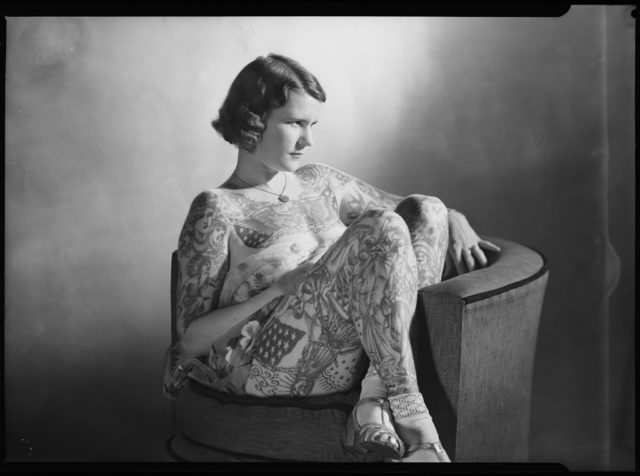

Betty spent most of her life touring circus sideshows, performing under the effective pseudonym of tattooed Venus. She refused to make up her own legend and insisted that body drawings without any stories draw attention to herself - as they say, "first of all, it's beautiful." Betty never stripped more than was acceptable at the time - her usual stage costume was a closed swimsuit - and she did not take part in vulgar shows.
Unwilling to arouse the public's interest with tales and overly explicit performances, Betty sought new ways to surprise audiences. So she became a participant in the horse shows that were gaining popularity at the time and for a while worked as a rider in a show called "Wild West".
Electrosila: the first tattoo machine
Over time, the need for circus legends completely disappeared. The tattoo sensation of the end of the XIX century became a married couple Frank and Emma De Burgh, who became famous all over the world as one of the first people, whose drawings were applied by an electric tattoo machine.
In 1891, the American Samuel O'Reilly invented the world's first tattoo machine, based on Thomas Edison's electric pen used for copying documents. O'Reilly improved on Edison's invention by equipping the machine with an ink reservoir and starting to use a bunch of interchangeable needles instead of one. The new device worked at a high rate, making several punctures per second.
Frank and Emma De Bourgh were the first to try it out: an image of the Last Supper appeared on Emma's back, and a huge crucifix with the inscription "Mount Calvary" appeared on Frank's body.
Tattoo addiction: the do-it-yourself master
If the previous heroes tattooed for the purpose of fame, to earn money or simply out of love for art, history knows such cases when the patterns on the body themselves became the main goal of the person, and even more - a real addiction.
That's what happened to Carl Ergel. The man was born in 1908 in Germany. As a young man, Carl saw three workers with tattoos on their faces and became obsessed with body art ever since.
Most of the images were applied to Ergel by the Hamburg tattoo artist Christian Warlich, who at one time even made the client the "face" of his advertising cards.
Over the course of 20 years, Varlich covered Karl's entire body with tattoos, but once rejected him: the man wished to have images on his hands. For the tattooist, this was not the only rejection: Herbert Hoffman, one of the world's most famous craftsmen, would not undertake to tattoo Carl's face because he thought it would disfigure him. In both cases, Ergel was not desperate and tattooed himself.
Patterns on the arms
On this part of the body, body worn patterns are popular. Artistic tattoos on the arms can be of the following types:
- "Long sleeve" - the pattern starts on the shoulder and ends on the wrist. It can be as the application of a single canvas, as well as several patterns;
- "Quarter Sleeve" - done from the shoulder and up to the elbow (a little higher);
- "Half Sleeve" - the tattoo is applied from elbow to hand or from elbow to shoulder.
Of course, you don't have to do nudes in the specified borders, it can be a small drawing. Or an inscription made on the wrist. Tattoos on the hands allow you to implement any creative ideas.
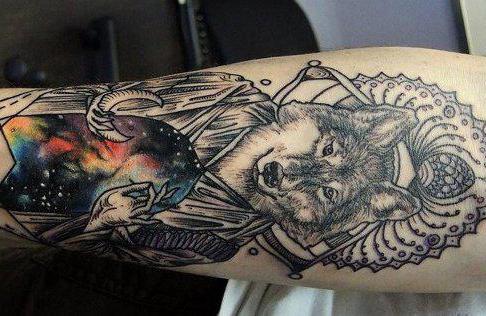

Modern Tattoo Culture: A Man with a Work of Art on his Back
The tattoo has long ceased to be an element of amusement. Now the drawing on the human body is a part of modern visual culture, a way of communication, and for some, a symbol of a transitional moment in life.
Such a moment was the tattoo for Tim Steiner, the former manager of a tattoo parlor from Zurich.
In 2006, the artist Wim Delvoie, famous for his provocative works, was looking for someone who was willing to become a living canvas. Tim was invited to participate in the project and he didn't hesitate to agree.
Two years later a tattoo appeared on his back: a praying Virgin Mary with a rosary in her hands, surmounted by a Mexican-style skull. Delvoie spent 40 hours on the job.
Later, Steiner signed a contract with a German gallerist under the terms of which a fragment of his skin with the tattoo would be sold to anyone interested after Tim's death.
Today he is a living exhibit: no less than three times Tim is required to exhibit his back in museums. Steiner himself says he has a work of art on his skin, and he's just a guy who wears it temporarily.
Eighteenth century: sailor tattoos - religion, superstition and bragging rights
Sailor tattoos were absolutely distinctive. These designs, a kind of splint, that is, a type of folk art, were based on easily readable images, such as the name or face of the mother (or beloved woman). Christian symbols such as crosses, rosary beads, and the silhouette of the Virgin Mary were a frequent motif: like crusaders, sailors were forgiven by the church for taking liberties with their bodies and the sacred symbols themselves.
A separate genre was the amulet tattoos (the sea element was unpredictable, and in those days a person could easily perish in a campaign). Sailors often tattooed images of pigs and roosters on their feet, usually on the upper part of the feet, because it was believed that the bearer of such tattoos would not drown. Why were such land animals as the rooster and the pig responsible for the rescue at sea? The logic is simple: on ships, cattle were transported in wooden cages, and in the event of shipwreck, the animals in them had a great chance of coming ashore and being rescued.
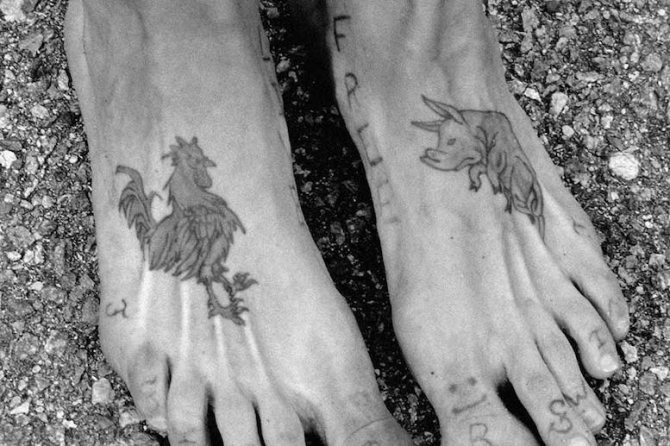

Images of a rooster and a pig - amulets against death in the sea waves
Of course, not all of the sailors' drawings on the body had deep meaning - some were just for fun and to brighten up the hardships of a long voyage: here went quite frivolous pictures, sexualized images of women. Seafarers bragged about these tattoos to their comrades over a mug of hot drink in the port tavern, and admired them during long watches.
It was the uncomplicated iconography of the sailor's tattoo that gave rise to the style we now know as old-school. These are drawings of relatively simple forms, outlined by thick black outlines and executed in simple colors. The style was based on the semantic component - that is, simple and clear symbols (religious, patriotic, referring simply to the joys of life and pleasures). The possibilities of the time dictated the technique - there were no typewriters to make finer lines and use more complex colors.


John Pratt/Keystone Features/Getty Images
Depp's Personal Diary: How to Turn Winona into Wine
Johnny Depp is arguably one of the most tattooed stars. The actor claims that for him drawing is like keeping a personal diary. His body depicts the highlights of his life: for example, Depp has a Native American chief tattooed on his right arm, a symbol of the fact that he has Native American blood flowing through him. The actor also has a tattoo in honor of former lover Winona Ryder, "Winona Forever," but after the breakup, Depp changed the inscription to "Wine Forever." The names of the children and mother are also imprinted on the star's body. This is only a small part of the images, the meaning of the rest of the tattoos Depp prefers to keep secret.
To learn more about the history of the tattoo and to see the exhibition of the Pushkin Museum you can in social networks on the hashtag #NaedinesPushkinsky.
Join the club
